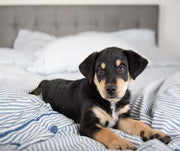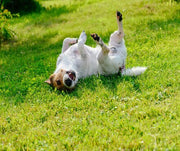How To Secure a Kennel in a Car

If a person gets caught in a car crash at 60 miles per hour without a seatbelt, chances are they would go flying out of the vehicle due to extreme impact. The same goes for your unrestrained dog sitting in the front or backseat of the car. Despite this, some of us still choose to drive around every day with dogs loose in the car.
With car accidents involving pets becoming more prevalent, it is now against the law to leave your pets unattended in a vehicle in at least 14 states and many local jurisdictions. In New Jersey, you can get fined up to $1,000 if you do not place your dog in a carrier or other restraint while driving. In Hawaii, the law directly states that you cannot drive with a dog on your lap. These regulations are not just about human safety but are meant to protect your pet's safety too. Despite these implemented laws, you and your dog's safety still lies in your hands.
In this article, we'll discuss the hazards of leaving your dog unrestrained during car travel, ways to keep you and your dog safe throughout the ride, and more specifically, how to secure a plastic kennel in your car to minimize distractions.
Unrestrained Dogs' Safety Hazards in Moving Vehicles
Dogs are called Man's Best Friend for a reason. Whether or not their presence is required, your dog usually wants to accompany you anywhere you go. Taking your dog along can surely make things more exciting and can even strengthen your bond. But taking the necessary precautions to ensure that you and your dog are safe is often overlooked. Only 16% of dog owners use a pet restraint when driving with their dogs. According to AAA or Kurgo Statistics, more than half of dog owners take their hands off their wheel to pet or calm their dogs during travel. This leads to being distracted while driving and the chances of a car wreck happening quickly rise.
If you and your 80-pound dog are involved in a car accident at 30 miles per hour, your dog becomes a force of 2,400 pounds. Such a force could kill not just the dog but the human occupant as well. Your dog can also be seriously injured by airbags located in the front seat of the car. Aside from the safety hazards mentioned above, dogs are also known to escape crashed vehicles and run away from the scene. This could cause another accident as other drivers would swerve to avoid hitting them. In some cases, dogs can even become aggressive with rescuers and delay emergency procedures if frightened or confused.
With those points discussed, what can you do to prevent any of these safety hazards from happening? Our top recommendation is the use of plastic kennels or crates during car travel. According to the AAA Foundation for Traffic Safety, a driver taking his eyes off the road for just two seconds doubles the chance of a car accident. Therefore, an unrestrained dog can cause a severe car crash in less than one minute.
According to the American Society for the Prevention of Cruelty to Animals, using carriers or plastic kennels is one of the safest methods to secure your dog in the car, especially when it comes to dog safety and preventing driver distractions.
A Comfortable & Tidy Option
Using carriers, crates, or kennels are some of the best ways to travel with your dog because your pup gets its own dedicated space. Keeping your dog restrained also helps to keep your car mess-free. Additionally, as the driver, you will not get distracted by an unrestrained dog roaming around the vehicle.
Various Choices for You and Your Dog
When it comes to choosing the best kennel for your dog, it's important to take your dog's size into consideration. You'll want to make sure that the kennel is not too large or too small. A dog should be able to stand up comfortably and have enough room to turn around and lay down. You'll also need to choose the style and material your pet is most comfortable with. For smaller dogs, you may consider a soft-sided carrier that comes with a shoulder strap so that you can easily transport your pet. For bigger dogs, you'll probably need to go the plastic kennel or crate route.
IF your dog is on the calmer side, is used to car travel, and can contain himself to the backseat, you can consider a vehicle safety restraint. These are basically seatbelts for dogs that secures your pet by their collar or harness.
Secure the Plastic Kennel

To secure a plastic kennel, place the kennel on the back seat behind the driver seat or passenger seat. Do not place the kennel in the middle seat. Grab your car's seatbelt and pull it around the length of the kennel and buckle it. Make sure your seatbelt is locked so that the kennel does not slide when you make turns. For larger plastic kennels, you may need to invest in safety straps that can be clipped onto your dog's kennel and buckled right into your seatbelt latch. If you're unable to find these, you may need to place the kennel in the cargo area of your SUV.
It is highly recommended that pet parents secure their pets in the back seat instead of the front seat.
Choose the Best Kennel For Your Dog
A classic dog kennel is made from plastic or some other lightweight, durable material. These are designed to be light and easy to carry (depending on size) for the owner's convenience. Some plastic kennels come with one front door, while others come with a second door on top of the crate. This second door makes it easier to load and unload your pet and is really useful if you are traveling with a cat!
We do not recommend wire crates, as these are not designed to handle the force of a car collision.
Keep Your Dog Comfortable

Choosing the right sized kennel is essential to ensure that they have enough room to sit up and lay down. But you can take it a step further and furnish the dog crate with a kennel mat or blanket. You may also line the kennel's sides with foam to protect them from any bumps in the road. Giving them ample food and water, as well as taking a proper first aid kit, are all critical as well.
Conclusion
It is a fact that dogs do not like being restrained in an enclosed space for hours at a time. They like being petted, played with, and entertained every so often. With how fussy they can get, especially in a moving vehicle, you'd be forced to keep them in the front seat, unrestrained, and cuddling with your while you drive. This occurrence can lead to dangerous situations. It's best to make your dog's safety and security a top priority by eliminating distractions. Keeping your dog securely restrained inside the right plastic kennel or carrier during travel is one of the most effective ways to do so.
Previous article

Next article

Related posts
View all-

How to Keep Your Pet Calm During Thanksgiving
Thanksgiving is a time for family, friends, and food, but for our pets, the holiday can be overwhelming. The sudden change in routine, unfamiliar faces and scents, and increased noise can trigger significant stress. Understanding why your pet might feel anxious is the first step toward creating a peaceful holiday experience for everyone, including your furry family members. This guide offers calming tips for pets and practical solutions to ensure your dog or cat feels safe and secure during the festivities.
Read Article -

Top Travel Essentials for Pets This Holiday Season
Holiday travel often means bringing the whole family along, and for many of us, that includes our furry companions. Preparing for holiday pet travel is about more than just packing a bag; it's about ensuring your pet's safety, comfort, and happiness from the moment you leave home until you return. A little planning helps reduce stress for both you and your pet, making the journey a positive experience for everyone involved.
Read Article -

Best Leashes and Collars for Daily Walks: A Pet Parent’s Guide
A daily walk with your dog isn't just a chore—it's a chance to bond, explore, and stay active together. The right leash and collar can make every walk safer and more enjoyable for both of you. With numerous styles and materials available, it's essential to find gear that suits your dog's needs and your lifestyle.
Read Article



